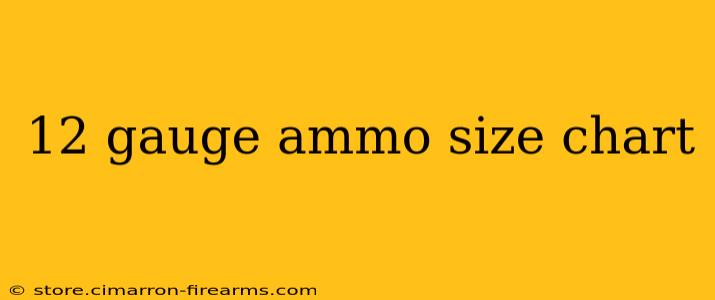Choosing the right ammunition is crucial for any shooter, whether you're a seasoned hunter, a competitive clays shooter, or a home defense enthusiast. Understanding 12 gauge ammo sizes and their applications is paramount to safety and effectiveness. This guide provides a comprehensive breakdown of 12 gauge ammunition, explaining the different shell sizes, shot types, and their intended uses.
Understanding 12 Gauge Shells: More Than Just Size
While the term "size" often refers to the gauge itself (12 gauge being a common standard), the actual size variations within 12 gauge ammo relate to the shell length and the payload contained within. Let's break down these critical aspects:
Shell Lengths: The Foundation of Capacity
12 gauge shotgun shells come in several standard lengths:
-
2 3/4 Inches (Most Common): This is the standard length for most shooting applications, offering a good balance between versatility and recoil. It's widely available and suitable for hunting small to medium-sized game, target shooting, and home defense.
-
3 Inches: Longer shells hold more shot or a heavier slug, resulting in increased range and stopping power. This length is popular for hunting larger game, waterfowl, and situations requiring greater penetration.
-
3 1/2 Inches: These magnum shells are the longest and most powerful commonly available. They are primarily used for hunting exceptionally large game or waterfowl at long distances, though recoil is significantly increased. Not all shotguns are designed to handle 3 1/2-inch shells, so check your firearm's specifications carefully.
Payload: The Heart of the Matter
The payload inside a 12 gauge shell determines its effectiveness for different purposes. Key payload types include:
-
Shot: Small lead or steel spheres. The size of the shot (e.g., #8, #4, 00 buck) dictates its use. Smaller shot is ideal for smaller game and target practice, while larger shot is for larger game. Buckshot is a larger, more powerful option for self-defense and hunting larger animals.
-
Slugs: Single projectiles, typically made of lead or other materials. They offer higher accuracy and stopping power than shot, making them suitable for hunting large game and longer-range shots. Rifled slugs further enhance accuracy.
-
Birdshot: Specifically designed for hunting birds and small game, birdshot uses smaller shot sizes (like #7 1/2, #8, and #9) for less destructive impact and more effective range on small, fast-moving targets.
-
Buckshot: Larger shot sizes (like #1, #00, and 000 buck) grouped together. Primarily for home defense and hunting larger animals, it has high stopping power at short to medium ranges.
The Importance of Consulting Your Firearm's Manual
Always consult your shotgun's owner's manual to confirm the maximum shell length it can safely handle. Using ammunition that exceeds the firearm's specifications can lead to serious injury or damage to the weapon.
Choosing the Right Ammunition for the Job
The optimal 12 gauge ammunition will depend entirely on the intended use:
-
Hunting: The choice of shot size, slug, or buckshot, and shell length will vary depending on the target species and hunting conditions.
-
Target Shooting (Sporting Clays, Trap, Skeet): The choice often depends on the specific discipline and personal preference. Many target shooters use 2 3/4-inch shells with various shot sizes.
-
Home Defense: Buckshot is frequently chosen for its stopping power at shorter ranges, though slugs are also an option for situations where over-penetration is a serious concern.
This information provides a foundational understanding of 12 gauge ammo sizing and its implications. Always prioritize safety and thorough research when selecting ammunition. Remember, the proper choice is critical for effective and safe shooting.

